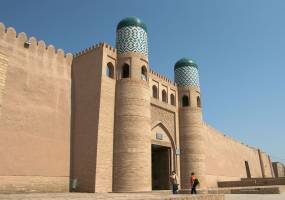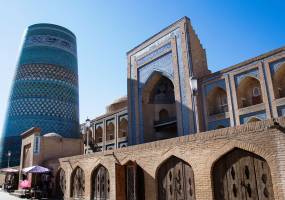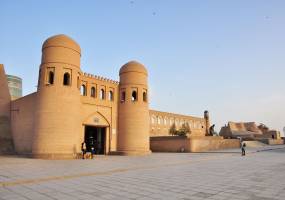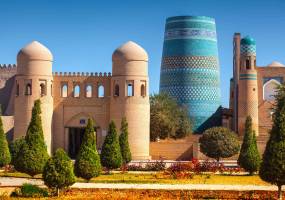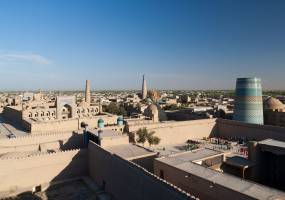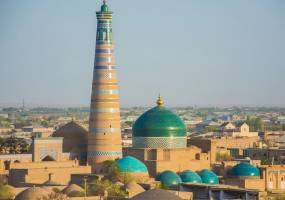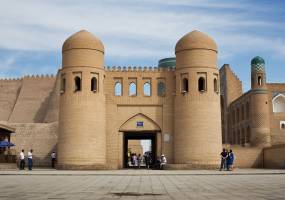City-reserve Khiva lies in the centre of the Kara-Kum desert, on the left shore of Amu Darya, 450 km away from Bukhara. The legend says that it was founded by Shem (Sim) – son of the legendary Noah. In former times Khorasmiya, later Khwarezm and Chorezm, had been one of the main centers of the Silk Road; in 16th century it was the capital of Timurids’ Dynasty; it served as the main slave market and centre of the khanate during three hundred years till its entrance into Russian Empire. It is useless to describe the city by words – you should see it. More than hundred monuments of different ages and nations have been kept there; that is why in 1967 Old Khiva, and in 1990 Itchan Kala were inscribed in the World Heritage List of UNESCO. Founded in 5th century BC, the oldest part of the town, being a part of Itchan Kala complex (“Old City”), is situated within the limits of ancient town wall. First fortress walls on this land were raised in 5th-6th centuries BC; in present days surrounded by the wall inner town includes nearly 60 historical buildings. Here you can see such historical monuments as Kunya-Ark citadel complex (1686-1888); Palvan-Darvaza eastern gates (1804-1806); Tash-Darvaza southern gates (19th); Baghcha-Darvaza northern gates (19th); Ata-Darvaza main gates (1842-1975); Tash-Khauli palace complex (Alla-Kuli-Khan palace, 1830-1838); Kalta-Minor minaret, entirely covered with glazed tile (1835-1955); famous Juma mosque with its 218 carved columns (1788-1789); symbol of Khiva – Islam Khoja minaret (1910, 56 m high); Palvan-Kari minaret (18th); Murad-Tura mosque and minaret (1888); Anush-Khan mosque and chambers (1657); mosques: Ak (1832-1842), Baglandi (1809), Khasan Murad Kushbegi (1802), Sheikh Mukhtar-Ata (1810-1838), and Yar Mukhammad Devon (18th), and also Akshi-Bobo bastion (17th), and Palvan-Kati trade complex (1905). Mausoleums of Pakhlavan Makhmud (14th-16th), Payandi (16th), Said Allauddin (1303), Tugon-Tura (19th), Utch-Ovlia-Bobo (15th-20th), and Yunus-Khan (1558-1559); madrassas of Arab-Mukhammad-Khan (1616-1834), Khojamberdibia (1688-1834), Shirghaziz-Khan (1718-1720), Sherghazi-Khan (1718-1726), Mukhammad Amin-Inak (1785), Abdulla-Khan (1855-1865), Kutlugh Murad-Inak (1804-1812), Khoja Maram (1839), Moosa Toora (1841), Mukhammad-Rakhim-Khan palace and madrassah (1846-1855), Mukhammad Amin-Khan (1851-1871), Amir Toora (1870), Matniaz Devan-beghi (1871), Mukhammad Rakhim-Khan (1871), Yakubbai-Khoja (1873), Dost-Alyam (1882), Mazari-Sharif (1882), Atajanbai (1884), Kazi-Kalyan (1905), Matpanabai (1905), Matrasulbai Mirzaboshi (1905), Matrasulbai Mirzaboshi (1905), Abdurasulbai (1906), Yusuf Yasulbashi (1906), Said-Bai mosque and madrassah (19th-20th), Tolib-Maksum (1910), Matniyaz-Divanbeghi and Kaz-i kalon, and also Alla-Kuli-Khan caravanserai and madrassah (1834-1835), and attached to it Tim with the same name (Tim – covered bazaar, 1836-1838) can be considered as religious buildings of Itchan Kala. The outer part of Khiva is called Dichan Kala. It re[resents dwelling and trade zone of ancient town, also surrounded by ancient walls. The following sights also deserve your attention: Dichan Kala rabad, its northern gates Kosh-Darvaza (20th), western gates Ata-Darvaza, restored gates Ghandimian-Darvaza (1842-1970), Khazarasp-Darvaza gates (19th), Tozabogh ark (1910) and Kibla-Tozabogh palace (1897), Nurulla-Bai palace (1910-1918), Said Niyaz Shalikar-Bai mosque and madrassah; mausoleums of Abdal-Bobo (12th-18th), Shakalandar-Bobo (16th), and Said Mukhammad Makhiriy (19th); also, Said Mukhammad Khan madrassah (1864), Tort-Shaffaz (1885), Bikanjan-Bika (1894), Mamat-Maram (1903), Palvan-Kari (1905), and Khorezm-shah (1915). Makhmud Pakhlavi mausoleum, Alla-Kuli-Khan caravanserai (19th), Said Allauddin mausoleum (14th), house of famous Khiva photographer Khudaibargen Devanov (1908), Matvafo Karvanboshi house (1910), and many other unique buildings are very interesting to visit. In the outskirts of Khiva you should see Atajan-Toora mosque and madrassaah (1893-1899), Ibrahim Khoja madrassah (1888), such minarets as Shakhimardan (18th) and Shah-i-mavlon (19th); also, mausoleums of Bibi-Khojar (1846), Sheikh Mavlon-Bobo (19th), and Shah-i-mardan (18th).
